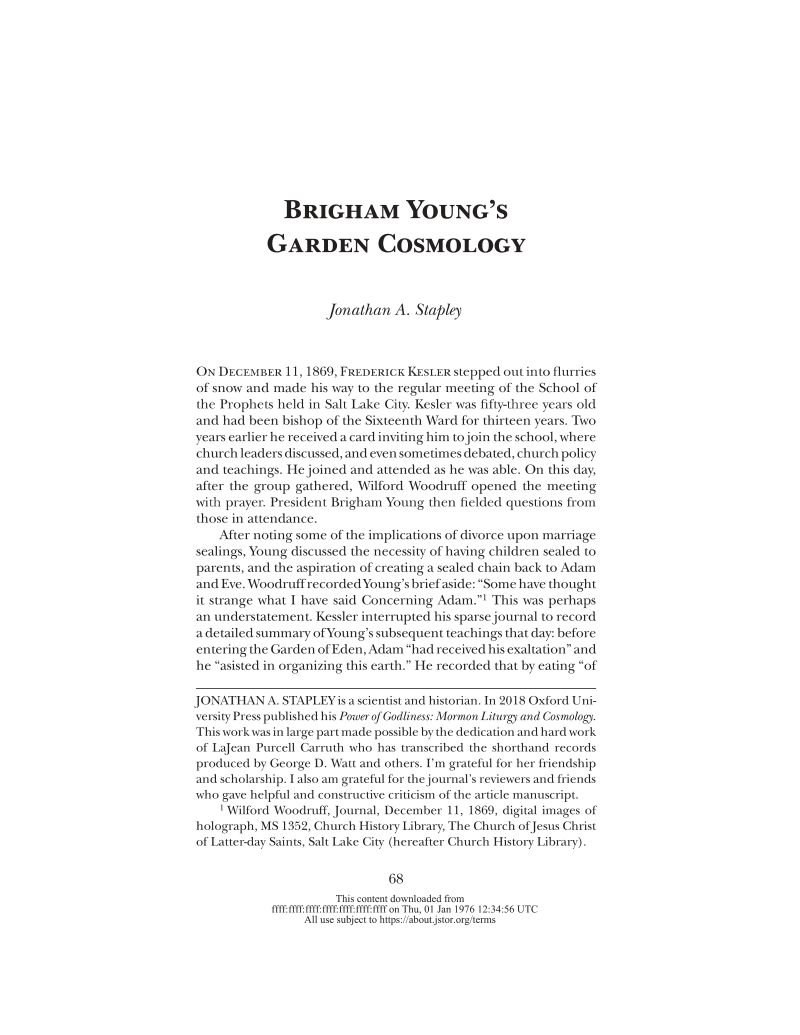Stapley's article examining the "Garden (of Eden) cosmology" that informs Brigham Young's understanding of Adam, God, and "spirit birth."
- Type
- Periodical
- Hearsay
- DirectSecondary
- Reference
Jonathan A. Stapley, "Brigham Young's Garden Cosmology," Journal of Mormon History 47, no. 1 (January 2021): 68-86
- Scribe/Publisher
- Journal of Mormon History
- Audience
- Reading Public
- Transcription
Young’s cosmology was a significant departure from the sacred texts of the church as well as Joseph Smith’s teachings. There was no need to worry, Brigham Young claimed, the scriptures and other related sources did not offer a reliable narrative of creation. They were, bluntly, “baby stories.” When confronting the teachings of the bible, he reverted to claims of natural law and biological imperative. Take, for example, the shorthand account of his sermon of June 18, 1865. Speaking of the creation of Adam and Eve, he stated: “God created he him male and female created he them . . . this is my view[:] he created him [Adam] just as you and I created our children[.] precisely for there is no other process in heaven or earth[,] under it or in all the eternities that is[,] were or ever will be[.] there are certain laws[,] rules[,] regulations to govern and control the elements and control the intelligence that is formed from the elements[,] and this process is from everlasting to everlasting.” Brigham Young asserted that sexual procreation is a foundational law of the cosmos. Thus Adam was not created from the dust of this earth, or from “adobe” as Young frequently mocked. Adam was no mere golem. He and Eve were born the same way every other human is born. Young explained that this process happened not on this earth, “but another earth” where Adam lived, died, and from which “he was exalted to thrones and kingdoms and principalities and powers.” Then he “came here and commenced a work.” According to Young, Adam and Eve were resurrected beings from another planet.
. . .
After fathering all human spirits, Young declared, Adam engaged in a work of creation and organization that yielded this physical world—earth. Once formed, he colonized this world with plants from another earth. And as Eve and Adam consumed these earthly fruits, they themselves became of the earth. As they “ate and ate and ate,” Young said, they became “charged with the elements that pertains to this world.” “His [Adam’s] seed that flows from that substance . . . forms the body” in the mother. Consuming the material food of this earth enabled Adam and Eve to bear bodies that were materially of this earth for their spirit children.
. . .
Young’s garden cosmology—garden because it is focused so intensely on the generative fecundity of life—was adopted by many church leaders for four decades, and certain aspects of it—viviparous spirit birth and the physical fatherhood of Jesus—became mainstream beliefs at least for a time. Bits and pieces persist to the present. Today church leaders boldly proclaim to the world that every human being is a child of “heavenly parents,” with many believers understanding this to mean viviparous spirit birth.
. . .
This article began by pointing to a contemporary recasting of Eve and Adam. One chapter in that volume was “What Adam and Eve Can Teach Us about Relationships.” This is indeed an important consideration. I asked why Brigham Young would have departed so radically from Joseph Smith’s Nauvoo cosmology and in a manner so aggravating to traditional renderings of the garden narrative. As discussed here, the basis of Young’s garden cosmology was biological reproduction—a significant revision of Smith’s exalted and gendered dyad of kings and queens, priests and priestesses. It is perhaps not a coincidence that Young began teaching his garden cosmology at the same time he publicly announced plural marriage. Perhaps his garden was a refraction of eternity through plural marriage’s prism—a way to render on the grandest of scales the procreative relationships that occupied the Saints greatest sacrifices. In doing so, he gave a narrative history to queens, priestesses, and a Mother god, and he unified humanity within the family of God. Young’s garden cosmology has been formally deprecated by church leaders, but these topics still pull at Latter-day Saint thinkers of all sorts, who can perhaps empathize with the power and perils of creative theology.
- Citations in Mormonr Qnas
The B. H. Roberts Foundation is not owned by, operated by, or affiliated with the Church of Jesus Christ of Latter-day Saints.

